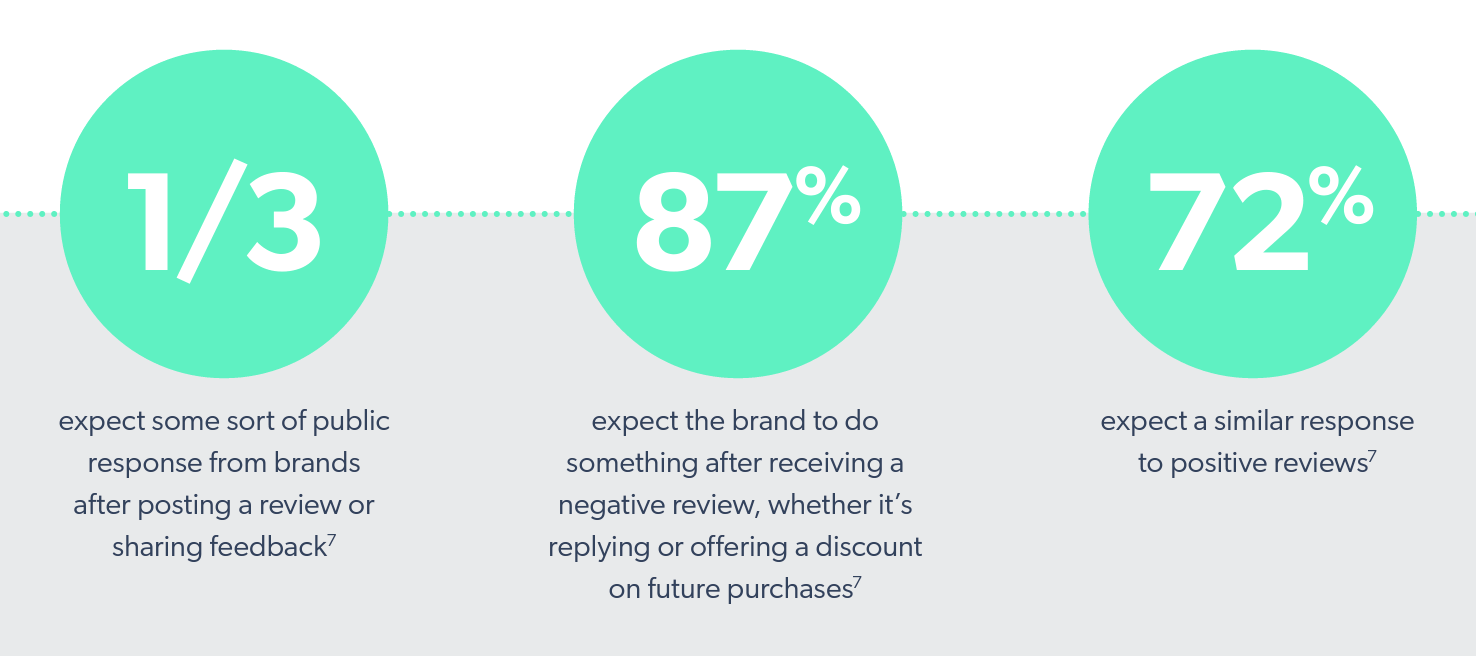March 6, 2023
Without sentiment analysis, you might as well be marketing your products to a brick wall. If you don’t know what your customers are thinking or saying, how do you know to retain loyal customers? Or win over unhappy customers?
This guide explains what customer sentiment analysis (opinion mining) is, types of customer feedback and sentiment to focus on, and what actions to take based on insights to improve products and customer experience.
Chapters:
- What is sentiment analysis?
- Types of sentiment analysis you can perform
- Four steps of the sentiment analysis process
- How to respond to types of customer sentiment
- 3 brand examples of sentiment analysis success
- Drive meaningful change with insights and reports
Imagine asking your roommate if they’d mind taking out the trash three times in one day. You didn’t say, “I’m frustrated,” but the fact that you’ve made this trash request multiple times within 24 hours is a pretty clear sign that you’re peeved.
That situation is sentiment analysis in a nutshell. Brands review the language that customers use to guess how they feel about your company. It’s a powerful tool for uncovering and addressing customer issues, boosting brand loyalty, and winning over future customers.
What is sentiment analysis?
Sentiment analysis, or opinion mining, uses data to measure and understand customer sentiment and opinions about a brand and its products. To conduct this analysis, brands use tools that review text with natural language processing (NLP) algorithms.
The technology identifies negative and positive words in customer communication and assigns an overall sentiment score.
The goal of sentiment analysis is to understand how customers perceive your brand and use that information to improve your customer experience. If you find out through analyzing the text in your online reviews that customers love a new lip gloss you just added, you might create others with similar colors and scents. You can also use sentiment analysis models to
- Help with market research
- Find new use cases for your products
- Get a feel for your brand reputation
Keep in mind, sentiment analysis does come with some challenges. It’s difficult for NLP tools to detect sarcasm and interpret slang words in a message. A sentiment analysis tool might identify a backhanded compliment as a positive message. Multilingual messages may also be a challenge for an NLP tool, which is typically trained in one primary language and may not pick up on some of the nuances if a message is translated.
Types of sentiment analysis you can perform
There’s several models of sentiment analysis, and each one has different purposes and provides different insights into your customers’ feelings. All sentiment analysis methods are used to understand your customers’ mindset, but where some involve using rating systems, others predict intent.
Fine-grained sentiment analysis
Fine-grained sentiment analysis is the process of categorizing customer feedback on a scale ranging from very positive to very negative.
Say you send a customer satisfaction survey with answers on a scale from 1 to 5. Fine-grained analysis would involve collecting those responses and sorting their feedback.
Or if you were to give customers open-ended questions, the sentiment analysis tool will also break down their sentences to look for any positive or negative words. It categorizes those responses for you so you can sort through them and find common threads.
So, suppose multiple customers rate the quality of a certain brand of shoe as negative. In that case, you know your company needs to look into quality assurance processes or suppliers and adjust your shoe-making process.
Emotion detection
Emotion detection is a process of analyzing customer language to identify their feelings. Are they angry or joyful about a product or the business? The results from an emotion detection analysis aren’t just restricted to positive or negative — emotion categories include anger, surprise, joy, disgust, anxiety, desire, and sadness. Or the less popular Seven Dwarves.
For emotion detection, you’ll need to add lexicons with lists of words that indicate positive or negative feelings to your NLP tool, like “frustrated,” “unhappy,” or “thrilled.” Once the sentiment analysis tool has those words in place, it will comb through your reviews, live chat transcripts, social media comments, and other text communications to sort them into emotion categories.
For example, your social media manager might report an increase in negative comments on Facebook, Instagram, and Twitter. You’d then run an emotion detection analysis on those to pinpoint the exact emotions your audience is feeling. Maybe they’re angry about a product you removed from your store, or anxious about new billing processes.
Once you know what’s contributing to their feelings, you can create an action plan to address the issues.
Aspect-based sentiment analysis
In aspect-based opinion mining, the purpose is very specific — to find trends in customer comments about traits of your products. You’ll then use that information to make changes in your products or services if they’re needed.
Let’s say you sell hockey bags and recently switched zipper suppliers, and want to know how customers feel about the quality of new zippers. Your aspect-based sentiment analysis might reveal that the zipper broke or stuck for the majority of customers, indicating you need to make an adjustment.
Or, if you recently changed an option in your subscription box, perform one of these analyses to see how customers’ feelings changed after the upgrade. If they’re using words like “frustrated” or “annoyed,” it’s safe to say they’re not loving the new change.
Intent-based sentiment analysis
An intent-based sentiment analysis attempts to predict your customer’s interests and intentions when they’re interacting with your company.
If a customer messages and asks, “Is there a discount on this item?” the NLP software might assume they’re considering a purchase.
Use this intent information to guide your marketing. You might be a toy manufacturer who only targets parents with advertising. But after conducting intent-based analysis on TikTok mentions of your brand, you realize pre-teens and adults represent a significant chunk of your customers. By only marketing to parents, you’re missing out on opportunities.
Four steps of the sentiment analysis process
From data collection to taking action, sentiment analysis is a multi-step process. Return to these steps regularly, so you can identify and address customer feelings before they escalate into problems.
1. Collect customer sentiment data
To identify customer sentiments, you need something to analyze: customer communication. Your sentiment analysis tool will continuously gather the data you’ll need from various sources, but you’ll need to help bring in new data by sending review request emails or interacting with customers on social media. Some sources your tool analyzes include:
- Customer reviews: Find these on Google, your website, and social media platforms
- Customer surveys: Send out net promoter scores, which ask a customer to rate your company from 1-10, surveys with multiple choice answers, or get open-ended survey responses
- Social media comments: See what customers are saying about your brand on Twitter, Facebook, Instagram, LinkedIn, and TikTok
- Emails, live chats, or texts: Pull remarks from customer emails, live chat transcripts, or any texts they’ve sent you
2. Analyze customer sentiment
After you’ve gathered all the data you need, use NLP tools to analyze customer sentiment data and identify the sentiment behind each message.
You could use open-source tools like Python to build your own in-house machine-learning software. But that’s a time-intensive process and you’d need someone with specific expertise. To make this process as convenient as possible, use ready-made SaaS products like an insights and reports tool that will help you see trends in your customer feedback.
With this tool, you can review recent product ratings and customer sentiment reporting all in one dashboard. You also don’t need to manually submit and review customer communication. Bazaarvoice automatically reviews customer communication on your site on a weekly basis, so you always have up-to-date customer sentiment information.
3. Identify customer sentiment trends
Once the data is analyzed, use data visualization tools like Google Charts, Tableau, or Grafana to view trends and patterns in your customer sentiment analysis over time.
Visuals give you a quick snapshot of how customers are feeling about a product or service. You’ll see where customer sentiment might be shifting and be able to spot emerging trends — like if shopper mood changes as soon as you change a recipe or upgrade your software.
When you know the trends, you can find areas of improvement and make informed decisions about your customer experience. If there’s an issue directly related to your products, send that information to your product manager so they can adjust.
Or if people are annoyed with customer service, let the customer service manager know.
4. Act on customer sentiment results
If customer feedback is negative, fix the underlying issue and communicate the solution to your customers. We’ll go into more detail on how to respond to various types of customer feedback in the next section.
How to respond to types of customer sentiment
No matter what type of customer feedback you receive, you should have a game plan in place to act on it. When a brand responds to customer sentiment, shoppers pay attention.
Nurture positive feelings and reach out to customers with negative (or neutral) sentiment to smooth things over and win over custom.
Address negative customer feedback
If customers leave negative feedback, take a look at the potential causes. Maybe a line of clothing runs too small or you took too long to respond to a question they had.
After you’ve determined the issue, let the customer know you take their feedback seriously. Apologize for any bad experiences they had and consider offering a discount or a refund.
For example, makeup company Il Makiage offers a discount code after a customer says they were unhappy with a product to try and repair the relationship.
Along with sending discounts or refunds, tell the customer you’ll find a solution to their problem. If they express frustration with the shipping process, work with your shipping company to get better delivery windows. If there’s an issue with product quality, sync with your quality manager to develop a better quality assurance process.
Finally, follow up with the customer. Customers expect a response to negative reviews. So make sure their complaint was either resolved or addressed in a satisfactory way. If you let complaints fall through the cracks, it’s harder to fix that negative sentiment.
Acknowledge positive feedback
It’s easy to get swept up in addressing negative feedback, but it’s also important to nurture customers by responding to positive feedback too. Tell them thank you for sharing their experience, and take extra steps like:
- Giving them a discount code as a way to show thanks
- Sharing their positive feedback on your website, on landing pages, or on social media
- Asking them if they’d be willing to review you on Google or social media
Make a note to follow up with these customers as well so you can check with them to see if they’re still feeling positive about your brand.
Figure out what’s causing neutral feedback
If a customer gives you neutral feedback, you have a chance to nurture them and try to win them over. They haven’t had a negative experience yet, but they also haven’t been wowed by your brand. Try to get them over to the positive side by giving them a great customer experience.
Reach out to them and ask if there’s anything you can do to improve, and thank them for sharing their thoughts with you. Let them know you’ll take any feedback and act on it to improve your products.
If they say your software doesn’t have a feature they need, let your developer team know and see if it’s something they can add. The best way to improve products is by leveraging customer feedback.
Again, follow up with the customer to let them know if their feedback was addressed. Give them a free trial or a discount to see if you can improve on their neutral sentiment.
3 brand examples of sentiment analysis success
Customer sentiment analysis is more than just reviewing customer data. It becomes much more powerful and has a long-lasting impact when brands take action on the information they get from that analysis.
Here’s some real-world case studies of businesses that looked at their customer sentiment analysis and fixed products or tweaked their marketing strategies as a result.
Électro Dépôt identifies products that don’t meet quality standards
Électro Dépôt, a European-based business that sells multimedia and home appliances, has 84 stores in France, Spain, and Belgium. They wanted to identify any products that didn’t meet their minimum quality standards.
A sentiument analysis of customer feedback helped the brand find those areas of improvement. One example: they sold a brand of speaker that couldn’t be used while charging. After noticing this feedback, the speakers were fixed and are now usable while they charge. More importantly, they were able to achieve a product satisfaction score of 4.1/5.
Électro Dépôt also plans to use customer sentiment to help decide on discontinuing products. The business has a goal to remove any products that receive fewer than three stars from customer reviews, as they want to market quality to their customers.
Nestlé Canada adjusts product recipe after seeing a dip in sales
You know Nestlé’s name, since it’s the world’s biggest food and beverage company with over 2,000 brands. But even the pros can get it wrong sometimes. In 2018, Nestlé Canada made some tweaks to the recipe of a well-loved tea. Once that tea hit the market, Nestlé started getting negative feedback online, along with a drop in sales.
Their customer experience ran a sentiment analysis of customer reviews, then sent the information from the reviews to their product team. A few months later, the company ended up going back to the original tea recipe.

After making the switch back, the average product rating went up from 1.7 stars to 4 stars. Their director of consumer experience said that the data from these reviews gave a lot of power to the decision to revert to the previous formula.
Consumers do the talking for us. They speak, and we listen and take action.
Lee Beech, Director of Consumer Experience, Nestlé Canada
Nestlé continuously receives customer reviews, so they use the solutions from Insights and Reports to help condense that data. Their customer experience team presents that review data, along with reports from customer service, to Nestlé executives to show them what their customer base is thinking.
Kidkraft offers new product option after getting customer feedback
Kidkraft sells children’s products — like dollhouses, swing sets, and outdoor playhouses. The company is understandably concerned with the way parents perceive their products and safety, so they recently started running a customer sentiment analysis every quarter, which shows recommendations for improving products and marketing.
In one case, customer reviews revealed that customers were building one of the popular playhouse models, but then painting them white. After KidKraft discovered this, they began offering a white version of the playhouse, leading to a significant increase in sales.

The company also changed the way one product was marketed after a recommendation from Bazaarvoice. Reviews showed that customers loved a storage bin underneath one of their play tables, but Kidkraft’s site didn’t even mention that bin. When Kidkraft’s team found this insight, they tweaked the product page and messaging to highlight that feature.
Drive meaningful change with Bazaarvoice’s Insights and Reports
To analyze your data efficiently, you need the right sentiment analysis tool by your side. Bazaarvoice Insights and Reports gives you a clear view into what your customers are thinking and feeling.
With our reporting tool, you’ll receive a weekly analysis of your customer reviews to see what they like and don’t like, and get actionable insights on how you can improve your products and marketing. We’ll tell you how to:
- Increase review volume
- Improve a low-performing email
- Refresh a product page with new copy
The tool will also show you how your products stack up against your competition, using our industry benchmarks that compare your ratings and reviews to your competitors. You can get in touch below to learn more. Or continue reading to learn how to find and use consumer insights.
Get started











